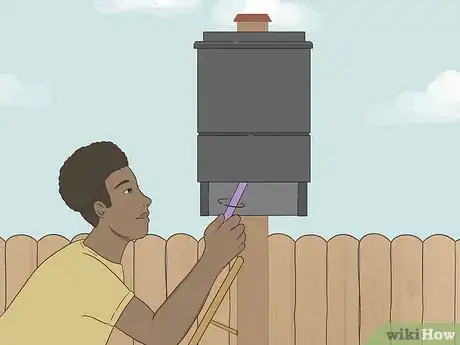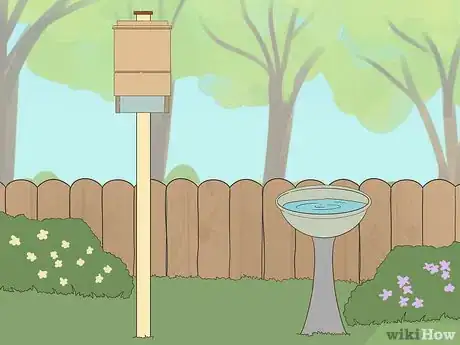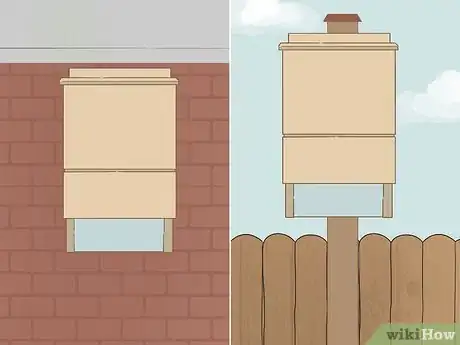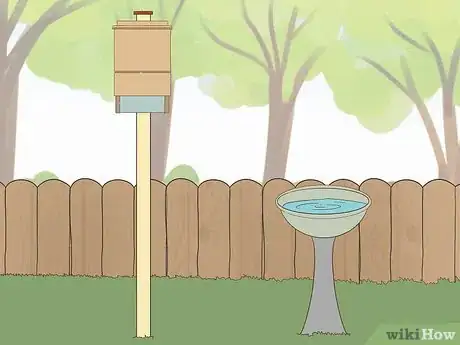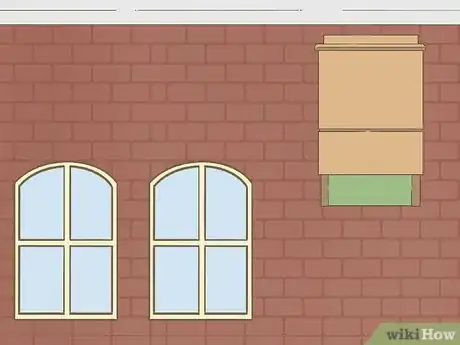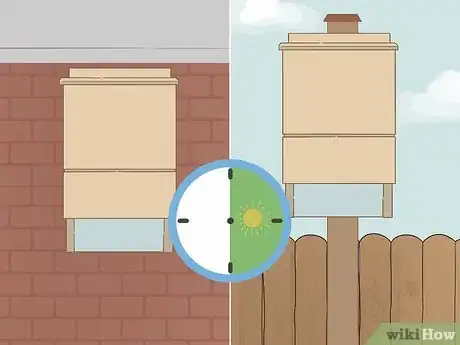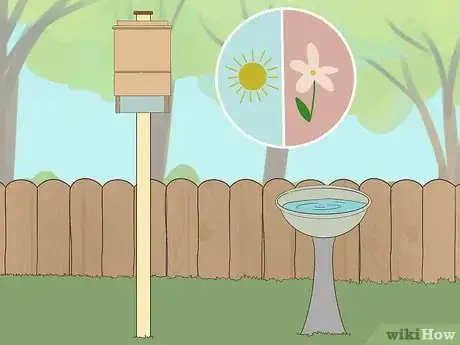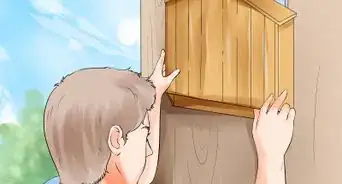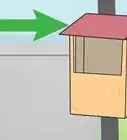This article was co-authored by Scott McCombe. Scott McCombe is the CEO of Summit Environmental Solutions (SES), a family-owned local pest solutions, animal control, and home insulation company based in Northern Virginia. Founded in 1991, SES has an A+ rating with the Better Business Bureau and has been awarded “Top Rated Professional,” and “Elite Service Award" by HomeAdvisor.
This article has been viewed 33,542 times.
Keeping a bat house near your home is a great way to naturally get rid of mosquitos on your property, as well as participate in bat conservation. However, bats are picky about where they roost. Taking steps to make sure your bat house is in a prime location at the right height, painted the right color, and close to water and plants will help create an ideal bat environment and keep them coming back.
Steps
Maintaining an Ideal Environment in the House
-
1Keep the bat house painted in the recommended color for your region. Use an exterior grade, water-based paint. The color you paint the bat box will influence the amount of light it absorbs and the internal temperature. Depending on where you live, you will need to paint the bat box in a dark, medium, or light shade:[1]
- In northern and high-altitude regions of the United States, paint your bat box in a dark color, like black or navy.
- In the Midwest and South, paint your bat box in a dark or medium shade of paint, like a medium shade of gray or blue.
- In the desert, paint your bat box in a light color, like light gray. Stay away from white paint unless the average daily temperature is higher than 100 °F (38 °C) in July.
-
2Clean the bat house once a year to keep out pests. Clean the bat house every winter after the bats have left for the season. Bat houses can attract wasps and mud daubers, so clean out any nests and remains left behind. Wear gloves and goggles and use a yardstick to scrape out any nests or accumulated dirt.
- Also keep an eye out for any leaks or drafts that need to be caulked to keep the bat house warm, and repaint the house if the paint starts to fade or peel.
Advertisement -
3Surround the bat house with plants that attract bats. Flowers that bloom at night can be especially attractive to bats. Try planting flowers like datura, moonflower, four-o'clock, yucca, evening primrose, night-blooming water lily, night-blooming jessamine, cleome, or nicotiana.[2]
- Growing plants native to your area might also attract bats since they are most likely to be what the bats already look for.
- If you want to remove a bat that has entered your house, isolate it to a specific room with a window.
- If the temperature outside is 50 degrees or above, open the window and allow the bat to leave without being harassed.
- If the bat does not fly, wear thick leather gloves, pick the bat with a towel, and quickly take the bat outside.
Positioning the Bat House
-
1Mount the bat house on the side of a building or pole. A bat house mounted on the side of a 2- or 3-story building without any obstructions will be easiest for bats to get to. The side of a tall pole also works.[3]
- The ideal height for a bat house is around 12 to 20 feet (3.7 to 6.1 m) off of the ground.
-
2Avoid mounting a bat house on a tree. It's best to keep bat houses off of trees since trees are too shady for most bats. They can also attract predators and can mess up a bat's flight pattern.[4]
- While bats sometimes naturally roost in trees, you will be more likely to attract bats if you mount the house on a building or pole.
-
3Put the bat house near a water source. Bats like to roost near sources of water. If you live within 1⁄4 mile (0.40 km) of a pond, lake, or river, you are more likely to attract bats.[5]
- If you don't live near a natural body of water, try adding a birdbath, fountain, or small pond to your yard.
-
4Keep the bat house away from artificial light sources. Bats prefer complete darkness at night. Mount the bat house away from any lights or lanterns that you have installed outside of your home.[6]
- Also try to position the bat house so that it faces away from any street lights.
-
5Place the bat house away from any windows, doors, or decks. Bat houses usually have an open bottom, which keeps excrement from accumulating. Bat waste drops directly out of the house to whatever is underneath.
- You can check the ground underneath the bat house for waste to see if you are attracting bats.
- Bat urine can strip the finish and paint off of decks.
-
6Position the bat house where it will get at least 6 hours of sunlight daily. The ideal temperature of a bat house is around 80 to 100 °F (27 to 38 °C). To make sure your bat house gets as warm as possible, put it somewhere on the building where it will get as much direct sunlight as possible.
- Placing the bat house on a south-facing side of a building is usually the best bet for keeping the bat house in the ideal temperature range.
- Mother bats are the pickiest when it comes to temperature. Male bats will tolerate a cooler resting place.
-
7Mount your bat house in spring or early summer. Bats like to find a place to roost for an entire season. The earlier in the season you mount your bat house, the more likely bats will be to find your bat house and settle there.[7]
- If bats don't show up the first season you install your bat house, be patient. Bat houses can take up to 2 years to attract bats.
References
- ↑ http://www.batcon.org/resources/getting-involved/bat-houses/build
- ↑ https://www.bhg.com/gardening/pests/insects-diseases-weeds/attract-bats-for-organic-insect-control/
- ↑ https://www.goodhousekeeping.com/home/gardening/a20706363/how-to-attract-bats/
- ↑ https://www.goodhousekeeping.com/home/gardening/a20706363/how-to-attract-bats/
- ↑ https://www.goodhousekeeping.com/home/gardening/a20706363/how-to-attract-bats/
- ↑ https://www.mnn.com/your-home/organic-farming-gardening/blogs/how-to-attract-bats
- ↑ https://www.mnn.com/your-home/organic-farming-gardening/blogs/how-to-attract-bats

